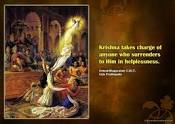The Three Phases of
Advaita Vedanta: Sravana, Manana, and Nididhyasana
Advaita Vedanta is one of the six schools of Indian philosophy and is based on the Upanishads, the Bhagavad Gita, and the Brahma Sutras. According to Advaita Vedanta, there is only one reality, Brahman, and the individual self, or Atman, is identical to Brahman. To attain this realization, one must follow the three phases of Sravana, Manana, and Nididhyasana.
Sravana refers to the
first phase of listening to the sacred texts. The Mahavakyas or the great
sayings, such as "Tat Tvam Asi" or "Aham Brahmasmi," are
considered the direct instrument of release. The second phase, Manana, involves
reflecting on the teachings and understanding them intellectually.
The third and final phase, Nididhyasana, involves continued meditation on the teachings until one attains direct experience or intuition of the self. The Bhamati school of Advaita Vedanta holds that Nididhyasana is the means to remove Avidya or ignorance, while the Vivarana school believes that Mahavakya is the direct means.
Vachaspati, the author
of the Bhamati, asserts that verbal testimony can only provide mediate
knowledge, which can be transmuted into immediate intuition only by deep
meditation. However, Surevara, in his Nashkarya Siddhi, disagrees with this
view and asserts that the immediacy or mediacy of knowledge depends on the
object of knowledge. If the content of Sravana is the self, which is most
immediate, immediate experience can arise from listening to the Mahavakya.
The reason why we do
not have this experience at once, even though listening to the sacred text, is
because of the obstacles in the way. These may be in the form of wrong
knowledge or lack of faith in the teachings of the Upanishads. When these
obstacles are removed, Sravana of the Mahavakya will lead to immediate
self-experience.
The example of the ten
travelers crossing the river is relevant here. When they reach the other side,
they count themselves and find to their dismay that they are only nine. The
tenth traveler points out that he himself is the tenth person, and they are
happy again. Similarly, wrong knowledge or lack of faith can be removed by
hearing the teachings of the Upanishads and belief in them, which leads to the
realization of the self.
Shuddh-Advaita:
Vallabhacharya's Doctrine of Divine Grace
Vallabhacharya, a
prominent Hindu philosopher, developed the Shuddh-Advaita or Pure NonDualism,
which posits the path of Pushti-marga or Divine Grace. According to this
philosophy, Brahmn is personal in nature, perfect, and the best of Beings.
Vallabhacharya saw Brahmn as assuming the form of the world itself, possessing
almost all the qualities of Para-Brahmn. The external world is real because it
is the material form of Brahmn, emanating from the Self itself for the sake of
divine lila or sport.
Vallabhacharya
interprets the Upanishadic Self from a different standpoint than Shankara's
Advaita. He bases his concept of Shuddh-Advaita on the notion of a personal God
in the Brihadaryank Upanishad, where Brahmn desired to be many, and the Self
manifested itself as a multitude of souls. For Vallabhacharya, Maya is the
instrument by which Brahmn reveals the world from itself, and not the illusion
which Shankara defined it as. His doctrine of Pushti-marga echoes the theistic
strain found in the Mundaka Upanishad - that the knowledge of the Self is
possible only through Divine Grace.
Vallabhacharya roots the immanence and transcendence of Brahmn in the figure of Krishn and develops his concept of Bhakti accordingly, giving it the character of a rasa or sentiment of love. God has assumed human form for the lila, to bestow His grace on the devotees. Liberation is to be sought in the interplay of emotions between the devotee and Krishn, in all the hues and colours of the Nav-Rasa or nine primary emotions. The Mukhar-Vinda Bhakti is the highest form of devotion, which is meditating on the physical form of Krishn, as the gopis of Vrindavan are alluded to have practiced unconsciously, in the Bhagavat Purana.
Vallabhacharya further
postulates that this liberation is to be had in the figure of Krishn as
Shrinathji, the boy Krishn lifting Mount Govardhan with his little finger. The
tradition has it that Vallabha had the inner darshan of Krishn in the form of
Shrinathji and was given the BrahmaSambhandha mantra, followed to this day for
initiation into the Pushti-marga.
In the Vallabha
tradition, complete surrender to Krishn seeking his grace lies at the heart of
Shuddh-Advaita. The consecration of the self to Krishn, according to
Vallabhacharya, awakens the soul to its real nature as part of God's
consciousness. While the tradition lays down regular seva or divine service to
God as part of the process, surrender to Krishn seeking his grace is the key to
realizing that the manifest world is only a lila of Brahmn.
IF HE EXIST
I drive joy there was a doctor in Benaras who
spent 7 minutes in the morning and evening for mediation on God. Knowing this,
his colleagues and friends laughed at him. One day they argued that he was
wasting 7 precious minutes on something, which he had been misled into believing.
The doctor replied, “Well, if God does not exist, I agree that I am wasting 7
minutes a day. But, if He exists? I am afraid you are wasting your entire
lifetime. I prefer to waste 7 minutes rather than a lifetime. Why should you
grudge me the 7minutes joy that I derive 4m.-
ILLUSTRATED REVIEW :7th heaven moment of the week in epl son 7 scored a goal ipl gt made 177/7 RRwon scoring
179/7











No comments:
Post a Comment